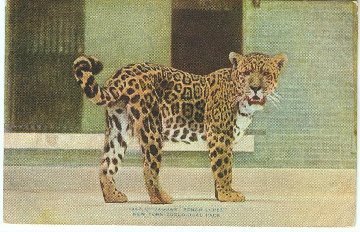
April 26, 2009

If you happen to live in the New York City area or have a forthcoming visit there, you might wish to plan on going to the Wildlife Conservation Society’s Bronx Zoo, sooner than later.

Remember, the Bronx Zoo’s unassumingly herd of bison was responsible for bringing the whole species back from extinction in the wild.
For cryptozoologists, we know it is often the truly unique and sometimes unnoticed or smaller species that can be as exciting as the big name lions, tigers, and bears, so often identified as “zoo animals.”

Due to the economy and required budget cuts, the Bronx zoo decided on April 24th to delete from its collection some rare, smaller, and what I must call “non-celebrity species.”

New York City’s Bronx Zoo, the largest metropolitan wildlife preserve in the United States, is dealing with a $15 million budget deficit and will be closing four exhibits and removing all their occupants, estimated to number in the hundreds of animals. The announced plan is that the animals will be relocated to zoos around the country, although it is a known fact that other zoos suffering harsh economy times have often quietly slaughtered their larger hoofed animals to be fed to predators, such as tigers.

Another old Bronx Zoo postcard. See Source D.
According to what can be gleamed from reports, the following animals will be gone soon from the Bronx Zoo collection.

The zoo residents mentioned are among the following.
All the species will be removed from the soon-to-close “World of Darkness” exhibition of bats, porcupines, sugar gliders, and several primate species, including lesser galago (Galago senegalensis), as well as other lemurs, bush babies, and night monkeys.

The rocking stone (a “logan stone” actually) shown in this 1905 Bronx Zoo postcard is a 40 ton boulder of pink granite. The Rocking Stone restaurant can be seen in the background. The boulder was moved in 1959 to the “World of Darkness,” where it was moved slightly so it could no longer be rocked. Source D.

Bronx Zoo postcard from 1944 shows a llama and children.
All the animals in the “Rare Animal Range,” and another exhibit, including the Formosan deer (Cervus nippon or Cervus taiouanus), South American guanaco (Lama guanicoe), foxes, other lemurs, and caimans, are due to be eliminated from the zoo.

One other exhibit being closed includes that of the Arabian oryx and blesbok in the southeastern corner of the zoo. The Arabian oryx (Oryx leucoryx) and blesbok (Damaliscus dorcas phillpsi or Damaliscus pygargus), two types of antelope. An endangered species, the Arabian oryx was hunted to extinct in the wild by 1972; reintroduction programs have since been attempted, with mixed success. The Phoenix Zoo is credited with saving the Arabian Oryx from extinction, and has been instrumental in breeding the Arabian oryx back from the eve of complete extinction. The blesbok were first discovered in the 17th century, and were found in numbers so numerous that the South African wild herds once reached from horizon to horizon, but that is hardly the case today. The blesbok was nearly hunted to extinction due to their perceived large numbers.
So, get out your field guides and take a visit to the zoo, before all the real celebrities disappear.

Once again, I highly recommend Elizabeth Cary Mungall’s Exotic Animal Field Guide.
But wait….

Quietly and with much less fanfare, the Bronx Zoo also concurrently announced, “In the immediate future, we will be opening exhibits with hyenas and aardvarks in the Bronx and snow leopards in Central Park.”
The photograph above is of a snow leopard taken at the Bronx Zoo.
This tends to reinforce my thoughts on “celebrity” vs “non-celebrity” species getting the nod in priority fiscal support decisions.

Keep us alive too….
About Loren Coleman
Loren Coleman is one of the world’s leading cryptozoologists, some say “the” leading living cryptozoologist. Certainly, he is acknowledged as the current living American researcher and writer who has most popularized cryptozoology in the late 20th and early 21st centuries.
Starting his fieldwork and investigations in 1960, after traveling and trekking extensively in pursuit of cryptozoological mysteries, Coleman began writing to share his experiences in 1969. An honorary member of Ivan T. Sanderson’s Society for the Investigation of the Unexplained in the 1970s, Coleman has been bestowed with similar honorary memberships of the North Idaho College Cryptozoology Club in 1983, and in subsequent years, that of the British Columbia Scientific Cryptozoology Club, CryptoSafari International, and other international organizations. He was also a Life Member and Benefactor of the International Society of Cryptozoology (now-defunct).
Loren Coleman’s daily blog, as a member of the Cryptomundo Team, served as an ongoing avenue of communication for the ever-growing body of cryptozoo news from 2005 through 2013. He returned as an infrequent contributor beginning Halloween week of 2015.
Coleman is the founder in 2003, and current director of the International Cryptozoology Museum in Portland, Maine.
Filed under Cryptomundo Exclusive, Cryptotourism, CryptoZoo News, Weird Animal News